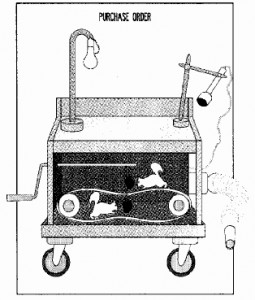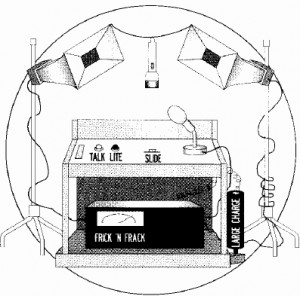Motivating your employees can help the wheels of your company run more smoothly and profitably.
 Our markets are getting more competitive, systems are becoming more feature-packed and complex, and we find our competitors are installing functionally identical systems and responding to the same specifications we are. In this environment, it’s not surprising that maintaining a distinctive identity or edge for your own company becomes more and more difficult.
Our markets are getting more competitive, systems are becoming more feature-packed and complex, and we find our competitors are installing functionally identical systems and responding to the same specifications we are. In this environment, it’s not surprising that maintaining a distinctive identity or edge for your own company becomes more and more difficult.
Certainly marketing, documentation and efficient project management will all differentiate you from your competition and help your bottom line. However, the part of your company that concerns your customers the most is your employees and representatives. The job they do and the impression they leave involve far more than shaking hands, explaining drawings and cut sheets, taking equipment out of boxes and hooking up all of those little wires. Motivating employees properly (your own and the subcontractors) is perhaps the biggest step you can take toward leaving the lasting impression that your organization is the one whose people do it right.
When I refer to employees, I mean anyone who could possibly influence your company’s reputation in the mind of anyone you deal with, not just customers. That includes the receptionist, answering service, accountant, even your answering machine or voicemail system. If they have a voice on your behalf, they represent you all of the time. And if it’s your job to help these people be their best, it’s not a responsibility to take lightly.
What do we stand for?
The first step is outlining what your company stands for and where you want to go. Our company believes strongly in a 5-and 10-year strategic plan, which works well for companies of any size or even for personal career goals. Proper planning lets people know what is expected and allows them to perform well.
Keep the plan flexible. As the world changes and new opportunities arise, don’t ignore them because they weren’t on the list. Likewise, don’t rush into anything just because it was scheduled to happen at a certain time.
I know of a small recording studio that did audio production, tape editing and post-production. The company had found a niche market and was doing well, developing a fine reputation and a good client list. According to the master plan, it was time to invest in video equipment and branch out into providing those services, and so they did. The hardware and computer editing systems rolled in, money was invested, and downtime was the word of the day.
When the sawdust and solder fumes cleared, the studio owner was hit in the head with a fact that could have saved him a lot of money and aggravation: He was already selling all of the audio time he could handle. The video gear would not bring in any new business or revenue until he expanded the overall facility and hired the personnel to accommodate the work. That phase was not planned for another two years on his master schedule, so it hadn’t occurred to him to reevaluate his goals.
A flexible and well-thought-out list of goals has no value unless everyone has a part and wants to contribute. That’s easy for a smaller company, but even for a bigger organization it can be done. Communicate these goals to everyone up and down the line and seek suggestions. If all of your employees are cogs in the wheel, let them all have a say as to how they can better make the wheel turn.
I recall a time I was frustrated by how things were running in my company. I decided to show them: I sat down and wrote up a list of problems and possible cost-effective solutions. Imagine my surprise when many of my suggestions were acted upon. Encourage the same and you might be surprised at the good ideas that come your way.
Expanding the group
People outside your immediate circle should also be aware of your goals and their contribution to them. Without letting your strategic plan out of the bag, you can let others know where you stand, what you stand for, and where you are going. And you should: There are many others who can benefit themselves and your organization by knowing this information. These people could include vendors, such professionals as accountants and lawyers, even your landlord and delivery people. They all have a financial stake, direct or indirect, in your company’s success and can be on the lookout for the appropriate opportunities (and pitfalls) when they come along.
 Another side effect of spreading the word can be a potential gold mine of referrals. At the same time you’re recommending a good accountant to an associate. Jack McSnoot of the McSnoot Skunkworks could be speaking to that same accountant about his expansion plans. If one good turn deserves another, you could find yourself installing the latest CCTV system and skunk detector in that shiny new factory of his. Aaah, the sweet smell of success.
Another side effect of spreading the word can be a potential gold mine of referrals. At the same time you’re recommending a good accountant to an associate. Jack McSnoot of the McSnoot Skunkworks could be speaking to that same accountant about his expansion plans. If one good turn deserves another, you could find yourself installing the latest CCTV system and skunk detector in that shiny new factory of his. Aaah, the sweet smell of success.
Outside employees
Except on very small installations, much of the challenge comes from working with representatives of other companies and subcontractors — in essence, your peers on a project. It’s effective to exchange phone numbers early on and let them know your commitment to the outcome of the job. We all know that you can settle little problems more quickly and easily in the field without resorting to change orders and red tape. If you need an outlet closer to a shelf and the electrical contractor needs information on what kind of VCR to get his wife for her birthday, perhaps a meeting of the minds is in order. It’s amazing how much mileage you will get out of showing up early with a couple of extra boxes of doughnuts.
When subcontracted employees are working for you, motivation can be a little trickier. You can’t reward these people financially, you don’t have the power to promote them, and you must work primarily with the training and skills they already possess. They don’t have ownership of the job or your company, and, although you might represent an important customer to the companies they work for, why should they go the extra mile?
I always start with the premise that everybody wants to do the job well. As corny as it sounds, people go home feeling better each day if they do the kind of work they can tackle with pride. Poor workmanship is often a product of poor organization and a lack of communication about objectives.
We start each subcontracted project with a meeting in which we review our goals for that job and promise to treat the subcontracted employees as if they were our own. A representative of our company reviews the project documentation with them; we don’t leave it to be passed on down the line. We tell them that we want their suggestions, and we seek them out throughout the project. These people have experience doing things differently from your usual methods, and many have been trained by your competition. You can learn from them or ignore them — the choice, and reward, is yours.
Throughout the project, we stress that we are not watching the clock. It is my contention that it costs much less to do things right the first time than to fix them later. By letting people do their best work, you let them motivate themselves. I tell people that this should be the project they brag about and reflect upon; if it’s not, the fault is their own. No one has ever let me down.
The day I stopped being a technician and started supervising others taught me the hardest lesson of my career: Being a boss is different from being a friend. When you are responsible for another person’s livelihood and that person’s performance affects your own earnings, friendship must take second place.
Large businesses have methods for tracking employee performance, performing evaluations and measuring productivity. The same methods are just as crucial to the smaller organization. When we’re working with friends, we sometimes take performance issues for granted, which will almost certainly end the friendship and possibly the employment as well — hardly the kind thing to do.
Pre-printed employee evaluation forms are available at many office supply stores. But it’s the idea of sitting down periodically and openly evaluating goals and performance that is most important. At the worst it points out problems before they get too serious; at best a dialogue can develop that may open eyes on both sides of the table.
If something comes up that you think would strain a friendship but is still important in a business context, you have to weigh the options. If you mention it, the problem might be corrected and the relationship will remain healthy. If you ignore things or work around the problem, it will only get worse and invite criticism from others; if the problem could solve itself, it would have. In my book the choice is clear, and if the employee is really your friend, he will understand.
Adding to the team
As your team expands and grows, with your employees naturally seeking their own niches, you must often add more people. This is a difficult part of managing business, and more qualified people than myself could write volumes on this process.
A universal agreement that cuts across geographic and product lines is that it’s difficult to find people that have the three primary qualities: motivation, reliability and ability to get along with others. “Find me a warm body who can come to work on time every day, wear the uniform and be willing to learn, and I’ll teach the rest,” says one employer. Another says he is constantly seeking out talent: “It is so hard to find the right people, so I’m always looking. If I come across someone, then I worry about where I can fit him in.” If you want your business to grow, after a certain point it all becomes a matter of somehow finding the right people to perform the work.
But the qualities we are looking for don’t come across on a resume. We can judge our employees’ technical abilities, for example, by their training and experience, but our impression of how they will fit our team is largely a turkey shoot — sometimes you buys a ticket and you takes a ride!
To minimize the risk, I rely on three things. The most important is a referral from someone who is already working with me. This is far different than a recommendation from an associate or friend, because no one wants to work side by side with someone who won’t fit in. If Tommy Tech praises Louie the Pipe and Louie just can’t seem to get it together, Tommy is going to feel some of the responsibility and share the extra work load. You can bet Tommy has thought of that before he mentioned Louie to you.
Second, introduce prospective applicants to as many of your present employees as possible, and not necessarily those with whom they will be working side by side. A receptionist candidate, for example, could meet members of the technical staff, and a technician should say hello to the salespeople.
What you are looking for is an impression, not an evaluation of the candidate’s merits; that part of the decision is up to you. You can accomplish two goals: You can learn of potential problems they sense on instinct (I know not listening to mine has gotten me into more trouble than I care to admit), and you can let your team feel they all have a part in choosing a new member. This feeling will speed along acceptance and cooperation with the new person.
Third, and admittedly a stereotype, is military experience. We’re looking for motivation, reliability and ability to get along, and these qualities are emphasized in the military more than anywhere else. I’m not saying it is the only criterion to use, but it could serve as a valuable tie breaker between prospective candidates.
Much has been written about holding meetings, but very little about why they should be held. Simply put, meetings should be important enough to meet the five guidelines listed below. If your gatherings don’t have at least this amount of significance, move them out of your office or conference room and hold them around the water cooler or coffee machine. To paraphrase, “Your time is a terrible thing to waste.”
- Purpose: Never hold a meeting without a good reason — and the fact that it’s a certain day of the week isn’t good enough. Respect people enough not to waste their time. Perhaps polling people the day before might uncover one or two items that could just be announced or discussed in smaller groups, freeing up the crowd to go about their business.
- People: The smaller the meeting, the more manageable. I don’t think anyone should ever be excluded, but perhaps more frequent meetings with smaller groups would be more productive. One large company I know has “team leader” meetings with management as needed and smaller “team” meetings to disseminate and collect routine and daily information. This system leads to a higher comfort level and an environment in which people are generally more willing to contribute. Few people feel as open when addressing a crowd.
- Plan: Make an agenda and stick to it. Cover all items before addressing new business. If possible, distribute a written agenda before the meeting; that way, people will have time to come up with items and topics. People feel more comfortable without the surprises.
- Pursue: Resolve each agenda issue before moving onto the next. If action is required, clearly define the party or parties responsible for getting the job done. Make sure everyone is satisfied with that topic and has had a chance to speak; you’ll save time and feelings later.
- Paperwork: Follow up on the meeting, where practical. This could consist of writing notes on your agenda and posting a copy on a bulletin board, writing and distributing minutes, or sending out a brief synopsis of what was discussed. This reinforces that the meeting was important and represented time well-spent.
 Keeping everyone involved
Keeping everyone involved
A philosopher (or maybe it was a bartender) once said that ideas are like dreams: Everybody has them and no one really wants to hear about yours. So let’s skip the obvious fact that by listening to others’ ideas you might stumble across some nuggets that set you on the path to fame and fortune. Pretend for a moment that you know everything and have no intention of entertaining suggestions, no matter how much sense they make. Your motto is “Don’t confuse me with the facts; I’ve made up my mind.”
Even in that (unfortunately all too common) situation, it’s a good idea to solicit feedback and suggestions. At the least, it will improve morale and cost less than raises, T-shirts and baseball caps. Everybody wants to he heard and appreciated, and people are usually more receptive to doing things your way if you’ve at least listened to their way.
Although project meetings – before, during and after a job – are an important forum for discussion, they shouldn’t be the only time to get feedback from your employees. Many people feel uncomfortable speaking up in meetings, and others will simply forget what they wanted to discuss by the time the meeting rolls around. Go on a fact-finding mission from time to time. During an installation or while you’re watching someone perform a repair, ask if they can think of a better way to do something or if others know and use the same techniques. Very often one person will come up with a better way to complete a task and just assume everyone already knows about it. Help share the wealth.
Motivating people is an improvement that costs nothing to implement and is almost guaranteed to have fast, significant results. But the most insidious side effect that makes the payoff truly rewarding is its reverse effect. If you become the team cheerleader and concentrate on making others more productive and satisfied, you’re bound to notice an equally positive change in your own attitude and performance. For many of us, myself included, that is payment enough.



